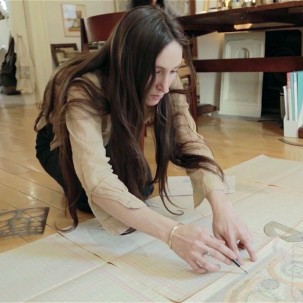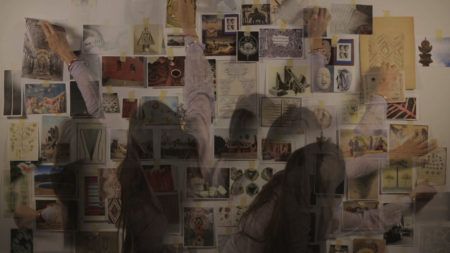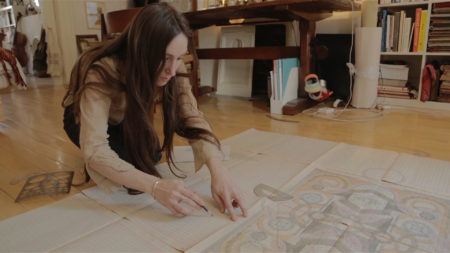Continue playing
(Time remaining: )
Play from beginning
Continue playing "{{ controller.videos[controller.getVideo(controller.currentVideo)].segmentParentTitle}}"
{{controller.videos[controller.getVideo(controller.currentVideo)].title}} has ended.
Drawing from Life in BaliLouise Despont
One of six new films from Art21’s fall 2019 programming
How deeply can a place permeate an artwork? A native New Yorker now working in Bali, Louise Despont shares how her adopted island home shapes her intensive practice, informing the devotional, meditative, and fragile elements of her drawings. “I know that the most important thing to make good work is time and space,” says the artist, “and living in Bali, that’s where I was going to have the most of it.”
While the spirituality of Bali aligned with Despont’s aesthetic, the tropical climate made her drawings vulnerable—a problem she solved with a dehumidified case. The artist herself was in a vulnerable place when she first arrived on the island in 2016, at the time of film; a long-standing relationship ended after they had moved to Bali together. “I wasn’t sure how I could make the work not being in love,” she says, but she soon found that her drawing practice sustained her. “Me in the studio with paper was there whether or not I was in a relationship.”
For her 2016 exhibition at The Drawing Center in New York City, Despont created an immersive drawing that imagines energy as a physical body, documenting its lifecycle from embryo to “a return to formlessness.” Conceptual artist Aaron Taylor Kuffner‘s gamelatron—a robotic version of the traditional Balinese orchestra, the gamelan—transformed the space into a sanctuary, and gave viewers the opportunity to, as Despont puts it, “travel through the drawings in their mind.”
Credits
New York Close Up Series Producer: Nick Ravich. Director & Producer: Wesley Miller. Editor: Wesley Miller. Cinematography: John Marton, Wesley Miller, and Andrew Whitlatch. Design & Graphics: Chips. Color & Mix: Anita Hei-Man Yu. Artwork Courtesy: Louise Despont and Aaron Taylor Kuffner. Music: Aaron Taylor Kuffner, Gunung Sari Peliatan, and Waroeng Sebatu Gamelan. Thanks: I Lanang Bagus, Nicelle Beauchene, Jasmine Cannon, Community of Penestanan, Community of Ubud, The Drawing Center, Mata-Mata (the cat), Molly Gross, Gunung Kawi Sebatu, Kent Henricksen, Ni Luh Putu Wiwik Krisnayanti, Ni Kadek Nopi Kristina, Brett Littman, Puri Agung Peliatan, Ni Nyoman Srimben, and Tirta Empul. © Art21, Inc. 2019. All rights reserved.
New York Close Up is supported by The Andy Warhol Foundation for the Arts; and, in part, by public funds from the New York City Department of Cultural Affairs in partnership with the City Council, and by individual contributors.
Closed captionsAvailable in English, German, Romanian, Italian, Japanese, Korean, Chinese, Italian
Through the Art21 Translation Project, multilingual audiences from around the globe can contribute translations, making Art21 films more accessible worldwide. Translate this video now.
Interested in showing this film in an exhibition or public screening? To license this video please visit Licensing & Reproduction.
Louise Despont was born in 1983 in New York; she lives and works in New York and in Bali, Indonesia. Since discovering the potential of working with pencil and architectural stencils on paper, Despont has adopted an intuitive process in which she allows her drawings to develop as she creates them, resulting in an almost devotional object comprised of dense colors and shapes. Having collected images for many years, Despont complements her broad visual references with her interest in energy and spirituality.
“Me in the studio with paper was there whether or not I was in a relationship. It’s definitely not as easy as when you’re in love, but it’s possible—and it’s so nice to have a practice that sustains you.”
Louise Despont



